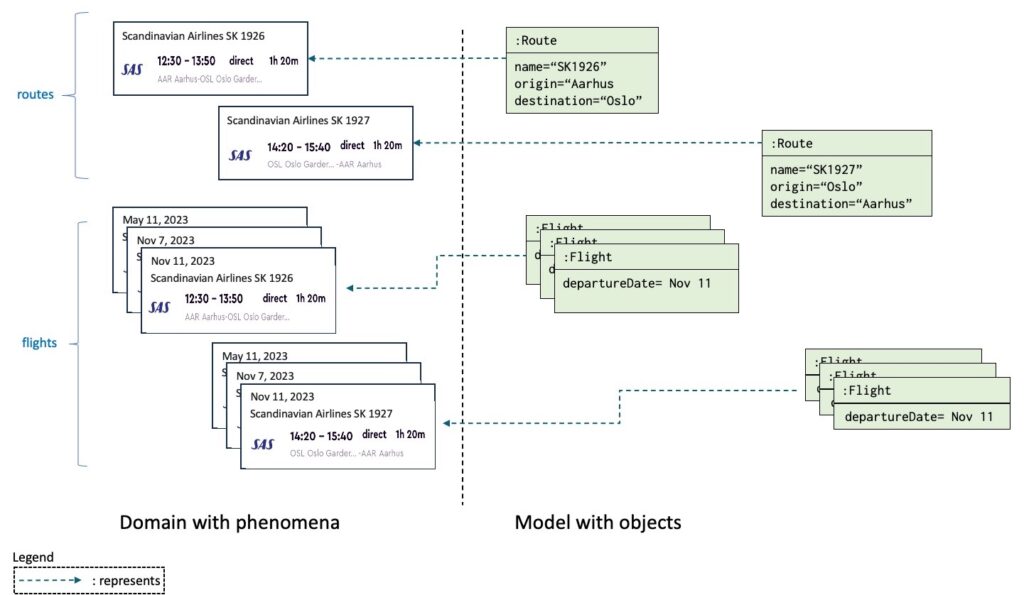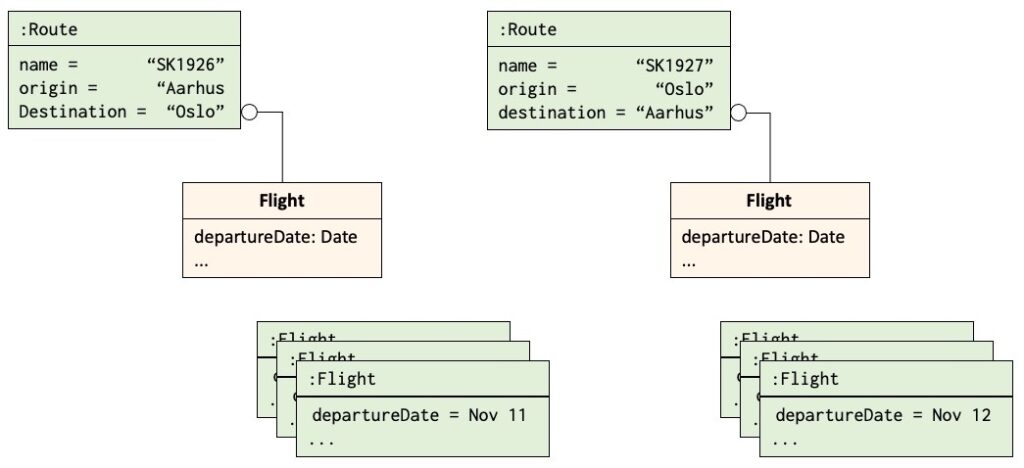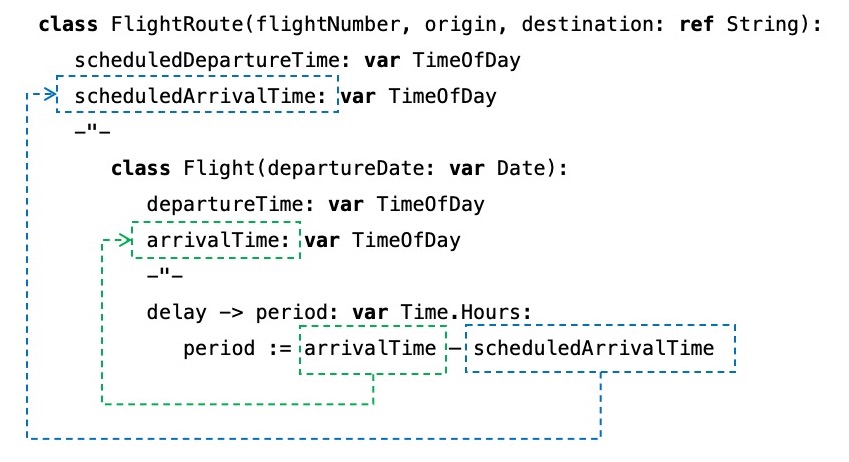In this chapter we illustrate nested classes by an example in the domain of flights and flight routes.
An airline company like SAS has a timetable with all their flight routes with flights, e.g. SK SK 1926 from Aarhus in Denmark to Oslo in Norway, and SK 1927 from Oslo to Aarhus.

A time table is used for two different purposes: as a basis for bookings, e.g as in the chapter on travel bookings, and as a basis for a website that shows the status of flights at a specific airport, i.e. whether flights are on time, cancelled, delayed, scheduled time of arrival, has arrived and at what time, etc.
Time tables, flight routes and flights are obviously represented by objects. A timetable has an entry for each of the different flight routes, and in the model each entry is represented by an object of class FlightRoute:
timeTable: obj
entries: obj OrderedList(FlightRoute)Each FlightRoute object has attributes that represent the flight number of the flight routes, the source and destination airports, the scheduled departure and arrival time, and scheduled flying time. The flights of a route is represented by a list of Flight objects for each FlightRoute object.
class FlightRoute(flightNumber, origin, destination: var String):
scheduledDepartureTime: var TimeOfDay
scheduledArrivalTime: var TimeOfDay
setTime(dt: var TimeOfDay, at: var TimeOfDay):
scheduledDepartureTime := dt
scheduledArrivalTime := at
flights: obj OrderedList(Flight)scheduledDepartureTime and scheduledArrivalTime are used for showing flight status, at airports or at the flight status website of the airline company. The type TimeOfDay is defined in section .
Setting up the flight routes of the time table is done by a sequence of actions that generate FlightRoute objects, set the values of their attributes and insert them into the timeTable:
SK1926: obj FlightRoute("SK1926", "AAR", "OSL")
Sk1926.setTimes(TimeOfDay(12.30 hours), TimeOfDay(13.50 hours))
timeTable.entries.insert(SK1926)
...
SK1927: obj FlightRoute("SK1927", "OSL", "AAR")
SK1927.setTimes(TimeOfDay(14.20 hours), TimeOfDay(15.40 hours))
timeTable.entries.insert(SK1927)
...As mentioned above, flights are represented by objects. As the notion of flight is defined in the context of flight route, the class Flight is defined in the context of the class FlightRoute. This is done by nesting the description of class Flight in the description of class FlightRoute:
class FlightRoute(flightNumber, origin, destination: ref String):
scheduledDepartureTime: var TimeOfDay
scheduledArrivalTime: var TimeOfDay
-"-
class Flight(departureDate: var Date):
departureTime: var TimeOfDay
arrivalTime: var TimeOfDay
delayDeparture(newTime: var Time.Hours):
delayed := True
departureTime := newTime
delay -> period: var Time.Hours:
period := arrivalTime – scheduledArrivalTimeThe type Date is defined in section and the type Time.Hours is defined in section :
Note that FlightRoute objects keep the flights for any date, while each Flight object has its departure date as an attribute.
Departure time is represented by departureTime. Before take off it represents the scheduled/estimated departure time. After take off it represents the actual departure time.
The scheduled arrival time is common to all flights on a flight route, while the arrival time of a flight is represented by a variable. Before take off is set to the scheduledArrivalTime and therefore represent the scheduled/estimated departure time. While flying it is set based upon flying conditions and landing conditions at the destination airport to represent the expected arrival time. After landing it represents the actual arrival time.
If the flight is delayed, the method delayedDeparture may be used to set the estimated departure time. In addition to assign the parameter newTime to DepartureTime, delayed is set to True.
As we have defined the class FlightRoute, so that each object of class FlightRoute represents a specific flight route, the class Flight is therefore defined in the context of class FlightRoute. A specific FlightRoute object will thereby have its own class Flight of objects representing flights on this flight route. Another FlightRoute object will have another class Flight.
The modeling of flight routes and flights is illustrated in the following figure. Each flight route is represented by a FlightRoute object, and the corresponding flights are represented by Flight objects held by the corresponding FlightRoute object.

The fact that class Flight is described nested in the description of class FlightRoute is illustrated in the next figure, using a circle-enclosed ‘+’ annotated relation between objects of class FlightRoute and the class Flight. A specific FlightRoute object will thereby have its own class Flight of objects representing flights on that flight route. Another FlightRoute object will have another class Flight.

The following illustration shows how nesting is used to compute the delayas the difference between scheduledArrivalTime and arrivalTime. By nesting the Flight class in the FlightRouteFlightRouteFlight. The method delay (in class Flight) may therefore compute the delay of the flight by subtracting the scheduledarrivalTime (in the enclosing FlightRouteFlight property ArrivalTime:

As mentioned above, we shall use this model of as the difference between scheduledArrivalTime and arrivalTime and flights for both booking of flights and for showing status of flights. In the next section, we look at what is required for booking, and then for the status of flights.
